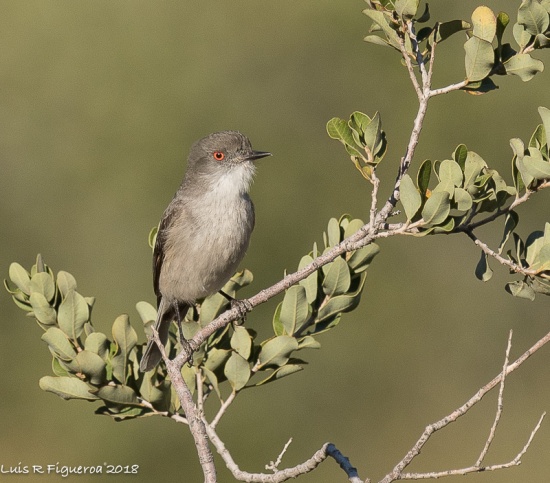
Photo © by Luis R Fiqueroa
Chacabuco, Santiago Metropolitan Region, Chile, 3 November 3, 2018
- Pyrope pyrope
Xolmis pyrope
Identification
Length: 18½–21½ cm. (7¼-8½ in.)
Bright red eyes are distinctive. Head and back are uniformly dark grey; wings are black with narrow grey edging; tail is grey, outer feathers slightly paler; pale ashy grey below, throat whiter, lightly streaked with grey. Bill and tarsi are black. Sexes are similar but the males have the tips of the two outer primaries strongly emarginate. Immature is similar but has brown, not red, eyes. Juvenile reported to have faint streaks on its breast and buff color along the edges of its wing coverts.
Similar Species
Ground-tyrants in the genus Muscisaxicola are more terrestrial with longer legs. They usually have pale lores and eyebrows, and a reddish or ochre crown patch. Diuca Finch is smaller, with a shorter, stubbier bill, broad white tips to the outer tail-feathers, a gray breast band, and cinnamon flanks.
Distribution
Taxonomy
This is a polytypic species[1] consisting of 2 subspecies.
Sometimes placed in the monotypic genus Pyrope based on the narrow primaries of the male.
Subspecies
- P. p. pyrope: Smaller and paler.
- Andes of central Chile and adjacent Argentina to Tierra del Fuego
- P. p. fortis: Larger and darker.
- Chiloé Island (Chile)
Habitat
Semi-arid woodland, scrub and lowland pastures.
Behaviour
Actions
They hunt from an exposed perch, sallying in the air for flying insects or dropping to the ground.
Breeding
Breeds from September to December. Female builds a small cup-shaped nest of dry sticks interlaced with grass stems and lined with lichen, moss, wool feathers or hair and placed in a tree or bush. The clutch is 2-4 creamy white eggs marked with red spots.
Diet
Mostly insects but they also eat fruit, especially in winter.
Movements
Mostly resident but southern populations migrate north in May returning in November.
Vocalisations
Calls include a soft, subdued pit or whit and a brief high-pitched tseet sometimes given in series. Song consists of short call notes terminating in a flourish: pit wheet whut T-T-wheeeooo.
References
- Clements, J. F., T. S. Schulenberg, M. J. Iliff, S. M. Billerman, T. A. Fredericks, J. A. Gerbracht, D. Lepage, B. L. Sullivan, and C. L. Wood. 2021. The eBird/Clements checklist of Birds of the World: v2021. Downloaded from https://www.birds.cornell.edu/clementschecklist/download/
- Portman, M., A. Brush, and T. S. Schulenberg (2013). Fire-eyed Diucon (Xolmis pyrope), version 1.0. In Neotropical Birds Online (T. S. Schulenberg, Editor). Cornell Lab of Ornithology, Ithaca, NY, USA. https://doi.org/10.2173/nb.fiediu1.01
- Farnsworth, A. & Langham, G. (2019). Fire-eyed Diucon (Xolmis pyrope). In: del Hoyo, J., Elliott, A., Sargatal, J., Christie, D.A. & de Juana, E. (eds.). Handbook of the Birds of the World Alive. Lynx Edicions, Barcelona. (retrieved from https://www.hbw.com/node/57424 on 23 January 2019).
- Jaramillo, A. 2003. Birds of Chile. Princeton & Oxford: Princeton Univ. Press. ISBN 978-0691117409
Recommended Citation
- BirdForum Opus contributors. (2024) Fire-eyed Diucon. In: BirdForum, the forum for wild birds and birding. Retrieved 19 April 2024 from https://www.birdforum.net/opus/Fire-eyed_Diucon
External Links
GSearch checked for 2020 platform.1




